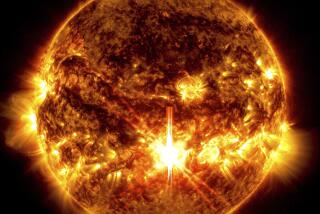An unusual ‘black moon’ is coming Friday, but it’s not the end of the world

Black moons occur when two new moons rise in one month.
This Friday, something unusual will happen in the sky over Los Angeles. Unfortunately, you won’t be able to see it.
Sept. 30 marks the emergence of the “black moon” — when a second new moon rises in one month. Like all new moons, you cannot see it with the naked eye, because the side of the moon that’s lit by the sun is facing away from Earth.
A black moon is not in any way different from a regular new moon, except for the fact that it occurs in the same month of the calendar as a previous one. The last new moon rose on Sept. 1. The black moon will rise about 5 p.m. this Friday, the last day of the month.
Many news outlets have reported this as a “rare occurrence.” A handful have suggested it’s a harbinger of the apocalypse. Ian O’Neill, an astrophysicist and the senior producer for space at Discovery News and Seeker.com, says neither of those things are true.
He started investigating the black moon this week when a headline appeared in the British tabloid the Express suggesting the “end of days” was upon us.
“I was very disappointed to find out black moon doesn’t mean an awful lot,” he said.
As to its rarity: “It doesn’t happen all the time, but it’s not particularly rare.” The most recent one was in March 2014.
A black moon is the opposite of a “blue moon,” when there are two full moons in one month. The lunar cycle is 29-and-a-half days. Every month except February has 30 or 31 days. So if the new or full moon occurs on the first day of any of those months, there will be a second one before the month has ended.
Technically speaking, saying something happens “once in a blue moon” means it happens once every two to three years.
Black moon isn’t even a scientific term. It’s not recognized by NASA. The phrase black moon has also been used to describe months where there is no full moon, and to describe a third full moon in a season that has four of them.
The public’s fascination with the black moon can be attributed to social media, O’Neill said. The “supermoon” and the “blood moon” both garnered a lot of attention, so it’s not surprising that people are interested in this lunar event as well.
“When you have anything that’s the least bit foreboding in the night sky, the media jumps on it,” he said. “Social media has a huge part to play. These things go viral.”
To underscore: This is an infrequent occurrence, but it doesn’t mean the world is ending. It’s just the moon doing its thing.
If anything, O’Neill said, he finds the moon “a bit boring.”
“I’m more of a black hole kind of guy,” he said.
Follow me on Twitter @jessica_roy and “like” Los Angeles Times Science & Health on Facebook.
MORE IN SCIENCE
The Rosetta orbiter is about to commit suicide, but first, a bit more science
Baby boy with DNA from 3 people offers hope for moms who would pass on deadly genetic diseases
Narcissists may start out popular, but people see through them in the long run







